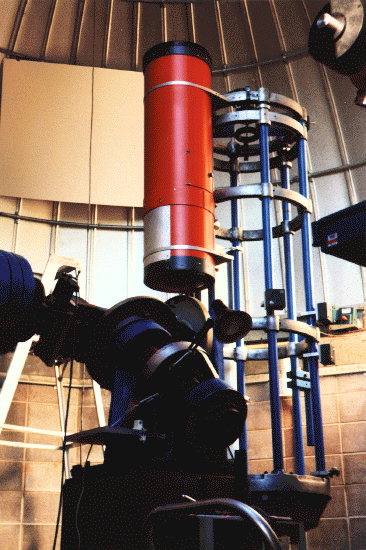

The "21-inch" (0.52 meter) Moore reflector celebrated its 50th year in 2005, just prior to retirement from its role as our primary research instrument. It was mounted with a companion 14-inch (0.35 meter) Celestron Schmidt camera on an exceptionally rigid and stable German equatorial. The primary telescope and its mounting were designed and constructed by the Louisville Astronomical Society between 1935 to 1955. The telescope is named for Walter L. Moore, who was responsible for coordinating its construction, and who tested and figured its primary mirror.
The Moore Telescope was originally located on Dr. Moore's property on Findlay Hill, south of Iroquois Park, in Louisville, Kentucky. The road to the site became known as Star Lane, and is still in use today. While that part of Louisville was a dark rural area in the 1950's, a decade later it was illuminated by the glow from a nearby shopping area, and it was no longer useful for visual astronomy. The telescope was generously donated to the University in 1974 when the construction of Moore Observatory on the University's Horner Wildlife Sanctuary was planned.
The modernized f/4.5 telescope was driven by encoded induction motors, and through computer control could take drift-scan images at its high-efficiency coma-corrected prime focus, or direct the collected light through a fiber optical cable to an astronomical spectrograph equipped with with a sensitive low-noise cooled CCD camera.
The Schmidt camera was used for recording images of comets, and for active galactic nuclei (AGN) monitoring programs that benefited from its exceptional field of view. The rapid obsolence of astronomical photography, and the increasing brightness of the sky at Moore Observatory, led to its retirement along with the larger telescope that guided it.
An exceptionally high quality instrument for its time, the telescope's main
drive gear was not precise enough for accurate sub-arcsecond tracking. Its primary
mirror, carefully crafted over many years by skilled amateur opticians,
was a solid 4-inch thick Pyrex disk. This design made it likely that the
telescope would not be in thermal equilibrium during the night because the glass
took many hours to cool down from warmer daytime temperatures.
Consequently, it was rarely possible to take full advantage of the
telescope's potential for research.
It is presently stored at Moore Observatory.

